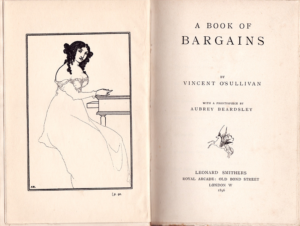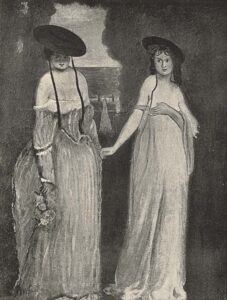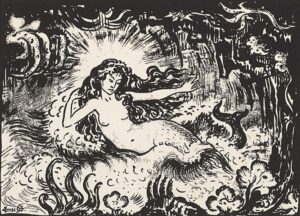On Vincent O’Sullivan’s “On the Kind of Fiction Called Morbid”
© Copyright 2022 Richter Alucard Ignacio, Toronto Metropolitan University
In the April 1896 edition of The Savoy, a short article whose breadth was less than that of four pages would be published. This article, Vincent O’Sullivan’s “On the Kind of Fiction Called Morbid“, though unassuming, offers a perspective on the industry of writing horror during the fin-de-siècle which has few surviving testimonies: that of the writers themselves, their experiences learning and adapting to a time of tumultuous cultural advance, and the reception they received from a public growing increasingly uncertain of what they want both from their art, and their politics.
It is through this perspective that I believe we can glean something valuable to the history of genre fiction, in this moment of horror’s evolution from the gothic themes of old, to a newer kind of responsive fiction (a theme we will explore later); that we can learn how genres developed during the fin-de-siècle and responded to the periodicity of their time.
But this all begins with the man himself.
On the Author
Writer Vincent O’Sullivan, not to be confused with poet Vincent O’Sullivan (from New Zealand!), lived something of a sordid life himself: As an Irish-American immigrant in the mid-1800’s and teetering on financial stability even well into his career as a writer (arguably, as many writers of his time would have lived), one can imagine the circumstances which brought him on to write chiefly in what he would style the “morbid” – those things which no good man would waste word on! – and this indeed has been the subject of interest of many of his biographers.
An account of his life from Robert Aickman’s The Fourth Fontana Book of Great Ghost Stories describes O’Sullivan, with the few words it dedicates to him, as “a master of this dyeing and soaking in guilt … O’Sullivan, having lived a longish life as a more or less well-to-do rentier, in latish middle age found himself ruined, wrote his last book (Opinions) under terrible conditions, and, dying in Paris, ended anonymously in the common pit for the cadavers of paupers” (Aickman, 9). Though none can make a direct connection between these detestable conditions he lived under and his larger body of work, it should not be said that any parallels one could think of are right out.
A short story from O’Sullivan’s A Book of Bargains, titled When I was dead is notable for being a story, quite literally, about a man seemingly having befallen his own death. After performing a sort of experiment involving human blood being kept in a vial during the night, a man named Alistair hears a loud crash which he investigates; and by no sooner does he get up to do so is he then met with two of the house’s maids, who seem to be shocked stiff by the sight of Alistair’s body – a body he cannot see. For the duration of the story, he stays in Ravenel Hall, where he purportedly died, watching his friends ponder what to do with his corpse, all the while attempting to interact with them, never once being noticed (he even seemingly phases through them when he makes contact) – and at the very end, during a snowstorm, he curses, “I’m not dead! Sweet God, I am not dead” (O’Sullivan, Bargains 140).
Though there is a complexity to the story’s thematic elements – the experiment Alistair having supposed have allowed him to interact with ephemeral companions which would follow him wherever he went possibly being an analogue for the wanting of companionship – the overarching theme is nonetheless the result of that experiment: Alistair becoming intangible to the world. We can relate this, in part, to the tragedy of O’Sullivan’s own life: Being an intangible part of society, this work of his being an outlet for that feeling of helplessness. In short, When I was dead is a proper horror story – and the horror it draws on is that same fear of becoming a ‘ghost’.

On Gothic Horror, or the “Morbid”
This theme of drawing on social fears that pervade the zeitgeist in which the author lives is central to the potency of a horror story. O’Sullivan’s On the Kind of Fiction Known as Morbid itself expresses many of the frustrations he had with writing on the genre, almost polemic in its criticism of the public reception horror had. “The thought of death is not pleasant! (folk may be imagined to exclaim),” O’Sullivan says with the wriest of sarcasm, “to escape that we laugh at the sorry farces and the works of Mr. Mark Twain; and yet, here is a zany with a hatful of dun thoughts formed to make one meditate on one’s tomb for a week!” (O’Sullivan, Morbid 168). There is an ire behind his words, an acknowledgement that horror had become a sort of opposite of the public purpose of reading; in it, there are no joys. O’Sullivan acknowledges that its subject matter is never the kind one would wish to dwell on for long.
But there is an ephemerality to this newfound emotion, O’Sullivan also argues. That this aversion to fear and the genre of horror, is a product of the current era and is by no means endemic to the population he writes for. Casting the light on Shakespeare’s Romeo and Juliet, O’Sullivan contends with the disgust for horror, excerpting a part of the play in which Tybalt’s corpse is found (all manner of disturbing adjective said aloud within), an excerpt O’Sullivan says “[he sees] the words: “exotic,” “morbid,” “unhealthy,” ready-made for that!” (O’Sullivan, Morbid 168). This analysis of the public mind, one of many which he performs throughout Morbid, bases itself around these ideas which society ought not to discuss; to think on.
In her seminal work, The Gothic Body: Sexuality, Materialism and Degeneration at the Fin de Siècle, Kelly Hurley introduces the visage of the “abhuman” – a sort of anti-ideal; the fear of fin-de-siècle America and England. The abhuman is that which man must never become, for to become it is to stop being man altogether. In Hurley’s words, it is the “ruination of the human subject. Such a ruination, figured in the most violent, absolute, and often repulsive terms, is practiced insistently, almost obsessively, in the pages of British Gothic fiction at the end of the nineteenth century and the beginning of the twentieth” (Hurley, 2). This idea of fin-de-siècle gothic horror chiefly forming around the ruin of its subjects is something which has already been discussed here: In O’Sullivan’s When I was dead, we witness the ruin of a man after becoming functionally intangible for half the story’s length. Paragraphs and exchanges are dedicated to the function of watching as the world around him – the world he was once in – adapted to his departure from it.
This brand of horror, Hurley describes, finds itself rooted squarely in that fear of departure. She describes the term’s origin in the word “abjection” rather than “abnormal” as one may think (Hurley, 3). It is the invocation of “being ‘cast away’ or ‘cast under, abased'” that both the term “abhuman” and gothic horror itself preys upon. For what is a fear if it is not itself afear’d? And one of the greatest fears of the fin-de-siècle was the growing ambiguity of humanity as an identity: As Hurley puts it, “[The Gothic] is positioned within precisely such an ambivalence: convulsed by nostalgia for the ‘fully human’ subject whose undoing it accomplishes so resolutely, and yet aroused by the prospect of a monstrous becoming” (Hurley, 3). If man truly was so mutable, so capable of both the horrific and of experiencing such horror, what would there be to separate them from the beasts? The inhuman? That was the true horror of the time – an end to that peaceable existence, free from worry of corruption.
On “This Poison-Bad World for the Romancer”
To speak more on the publication O’Sullivan’s article – and the movement that periodical was associated with – the ways in which Aestheticism affected genre fiction (and horror in particular) are difficult to discern. The movement itself survived little in the way of communication between its belligerents, especially those of less note or those who participated far less in the Aesthetic community, such as O’Sullivan. However, we can still trace some facts to perhaps silhouette some ways in which O’Sullivan and other Gothic horror writers may have changed during the fin-de-siècle.
The Savoy was a short-lived periodical that was in publication for exactly one year – 1896. It saw a number of high-profile names in Aubrey Beardsley, Max Beerbohm, W. B. Yeats and Leonard Smithers aboard its deck, but despite this could not shake off these names’ proximity to the then-criminal, and highly scandalized, Oscar Wilde. Indeed, even O’Sullivan himself in the modern cannot escape being written about in approximation to Wilde’s orbit: “Of the few people familiar with the name of Vincent O’Sullivan today, some probably know his book on Wilde,” Anthony Powell writes, on the single page dedicated to O’Sullivan in his encyclopedic Under Review: Further Writings on Writers, 1946-1990. Perhaps it is this distance, and overshadowing circumstance, which blotted out what we could tell about Gothic horror writers’ lives during the fin-de-siècle.
But O’Sullivan still has bones to pick which may tell us more about the place of horror in the 1890’s lifestyle. In Morbid, he dedicated a not-insignificant number of words to lambasting the difficulties of being published as a horror writer, describing editors, “those cocks that show how the popular wind blows, if they have no kicks, have few ha’pence for the writer of stories which are not sops to our pleasure” (O’Sullivan, Morbid 168) – a searing truth of the consequences of the public aversion to horror. He could not be but published when writing horror! Furthermore, he speaks on the what the public does seem to enjoy reading: “…for it is more easy – if more degrading – to write a certain kind of novel” (O’Sullivan, Morbid 169); this kind of novel, as he then described at mocking length through an archetypal caricature, is the romance. Tales of grandeur from humbleness, and morals which are so easily read in the text.
There is a repulse which can be sensed from O’Sullivan’s description of even these vague concepts, perhaps because he hates to see them overturn the genre of horror which can certainly still have virtue. As throughout the rest of the article, describing how the people of the fin-de-siècle viewed horror, O’Sullivan’s raison d’etre within is to point out a central hypocrisy: The zeitgeist concerned itself too much with the outer shell of the product; the stench of a dead body or the sight of a human carcass. That fear of the abhuman. The ability to appreciate horror, as O’Sullivan expresses, was becoming lost. Only those tales of romance and direct moral instruction, made popular by his contemporaries and amplified by the public response to them, saw the light of day. It may have been a “poison-bad world for the romancer” as O’Sullivan began his article, but perhaps it is that longing for a less “bad” world which drove horror to obscurity.


Onwards to a Better Fiction
In examining this article by O’Sullivan, we have borne witness to perhaps the most unfortunate obscurity in genre fiction: Gothic horror’s change from the nineteenth century to the twentieth. There were indeed no clear through-lines, but there did exist the remnants of the forces which made it so. The growingly poor reception to horror made it thus unprofitable, and this was exacerbated in its disappearance during the periodical era, in which the popular books were seemingly all but horror. Those same periodicals had few allying views with the horror writer, favouring a certain kind of fiction in lieu of it. Yet through this adversity, horror thrived. From the time of Poe to the time of Lovecraft, that faint wisp of the genre sparked from being at the mercy of public opinion, to responding to it. Embodying what it truly feared – becoming what Hurley coined the “abhuman.”
It is, then, an inspiring tale of sorts, that exposes how to deal with the adversity of a hostile or ambivalent public to one’s work. What writers can target – exploit – to their gain. How to take the public’s heart, ink-black blood spilling hence, and grasp it with the mightiest conviction.
Works Cited
O’Sullivan, Vincent. “On the Kind of Fiction Called Morbid.” The Savoy, April 1896, pp. 167-170.
O’Sullivan, Vincent. “When I was dead.” A Book of Bargains, London, Leonard Smithers, 1896, pp. 128-140.
Powell, Anthony. Under Review: Further Writings on Writers, 1946-1990, University of Chicago Press, 1994.
Aickman, Robert. The Fourth Fontana Book of Great Horror Stories, 5th ed., Fontana Books, 1972.
Hurley, Kelly. The Gothic Body: Sexuality, Materialism, and Degeneration at the Fin De Siècle, Cambridge University Press, 1996.
Images in this online exhibit are either in the public domain or being used under fair dealing for the purpose of research and are provided solely for the purposes of research, private study, or education.
